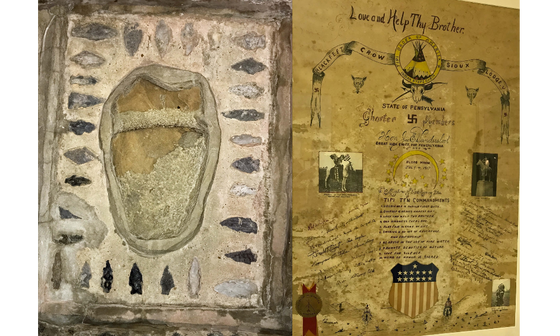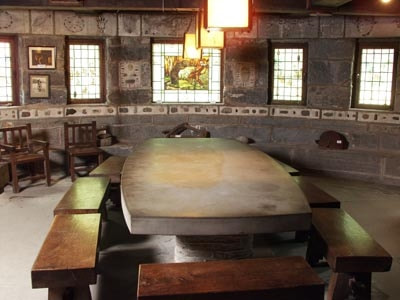Permanent Exhibits At Indian Steps Museum
Vandersloot traveled extensively throughout North and South America visiting archaeological sites and tribal leaders. He admired the social & cultural structure of all Native Peoples and duplicated specific aspects of each tribe, which is reflected through the museum via structure, art, photos, regalia and artifacts. Acting as an ambassador, he invited many elders to visit Indian Steps Museum, where gifts were exchanged and adoption ceremonies were performed.
Vandersloot traveled extensively throughout North and South America visiting archaeological sites and tribal leaders. He admired the social & cultural structure of all Native Peoples and duplicated specific aspects of each tribe, which is reflected through the museum via structure, art, photos, regalia and artifacts. Acting as an ambassador, he invited many elders to visit Indian Steps Museum, where gifts were exchanged and adoption ceremonies were performed.
|
Kiva Room
The Kiva Room is a structural example of an underground ceremonial room used by the Ancient Pueblo Peoples of the Southwest. Vandersloot wanted to emphasis the spiritual aspect of this counsel room with circular stone seating where important community meetings and tribal decisions were conducted. A large Ohio blue stone table, weighing 2.5 tons, is the centerpiece along with local artifacts embedded into the shape of pictographs within the walls. |
Stained Glass
Stunning stain glass panels depicting Indian scenes were created by J. Horace Rudy, a well-established 1906 glass company located in York, which become the largest stained glass company in the country. Chet Boyer was the glass cutter and Hay Gilbert was the glass painter who depicted Jessie Cornplanter Seneca Village life designs.
Stunning stain glass panels depicting Indian scenes were created by J. Horace Rudy, a well-established 1906 glass company located in York, which become the largest stained glass company in the country. Chet Boyer was the glass cutter and Hay Gilbert was the glass painter who depicted Jessie Cornplanter Seneca Village life designs.

Vandersloot Room
Documents the history and photos of Vandersloot and others who kept his vision alive. Gifts given to Vandersloot by various tribal elders are on display, plus photos of Vandersloot acting as High Chief of the Order of the Tipi. At the height of the Pan Indian Movement in the early 1900’s, the Order of the Tipi was an organization dedicated to promoting the ideals of Native Americans.
Documents the history and photos of Vandersloot and others who kept his vision alive. Gifts given to Vandersloot by various tribal elders are on display, plus photos of Vandersloot acting as High Chief of the Order of the Tipi. At the height of the Pan Indian Movement in the early 1900’s, the Order of the Tipi was an organization dedicated to promoting the ideals of Native Americans.
Timeline
Travel back in time (16,000 B.C.) to when Mastodons roamed our area and nomadic paleo Indians hunted large game animals for food. View the timeline which depicts the development of Native Peoples along the Susquehanna River from Paleo to Contact Period. Local artifacts range from stone tools, projectile points, early pottery and introduction of trade items such as brass pots, iron axes, and European glass beads changed the Native Peoples ways of life forever.
Travel back in time (16,000 B.C.) to when Mastodons roamed our area and nomadic paleo Indians hunted large game animals for food. View the timeline which depicts the development of Native Peoples along the Susquehanna River from Paleo to Contact Period. Local artifacts range from stone tools, projectile points, early pottery and introduction of trade items such as brass pots, iron axes, and European glass beads changed the Native Peoples ways of life forever.
Susquehanna Room
Read about the Beaver Wars and how the Susquehanna Indians fought to establish their dominance in the fur trade. See how pottery was made and the display of highly decorated Susquehanna pots reproduced by resident artist Larry Saylor. Discover the meaning of the Susquehanna spirit face effigy found on their pottery at Washinton Boro, PA.
Read about the Beaver Wars and how the Susquehanna Indians fought to establish their dominance in the fur trade. See how pottery was made and the display of highly decorated Susquehanna pots reproduced by resident artist Larry Saylor. Discover the meaning of the Susquehanna spirit face effigy found on their pottery at Washinton Boro, PA.
Local Collectors Room
On display are local Indian artifacts donated by collectors, who wanted to share their finds and encourage appreciation for primitive technology. See large collections of stone axes and other artifacts from York, Lancaster, Cecil and Harford Counties.
On display are local Indian artifacts donated by collectors, who wanted to share their finds and encourage appreciation for primitive technology. See large collections of stone axes and other artifacts from York, Lancaster, Cecil and Harford Counties.

